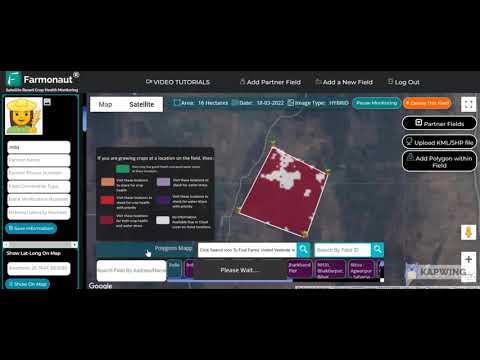North American Grain Market Shifts: Canola Futures Surge Amid Global Oilseed Production Updates
“Canola futures surge by double digits amid global oilseed production updates, impacting North American grain markets.”
In the ever-evolving landscape of global agriculture, we at Farmonaut are witnessing significant shifts in the North American grain and oilseed markets. Our latest analysis reveals a noteworthy surge in canola futures, driven by revised production estimates and complex market dynamics. This comprehensive report delves into the intricate world of agricultural commodities, exploring how weather patterns, geopolitical tensions, and technological advancements are reshaping crop yields and market trends across the continent and beyond.
As we navigate through this detailed exploration, we’ll uncover the latest developments in CBOT grain prices, examine the delicate balance between supply and demand in the oilseed sector, and shed light on how precision agriculture techniques are revolutionizing crop yield estimation. Join us as we unravel the complexities of the global agricultural landscape and its implications for farmers, traders, and industry stakeholders.

The Canola Conundrum: A Deep Dive into Futures and Production
The North American grain market is currently experiencing a significant upheaval, with canola futures taking center stage. This oilseed, primarily grown in Canada and the northern United States, has seen a remarkable surge in futures prices, catching the attention of traders and farmers alike. Let’s break down the factors contributing to this canola craze:
- Weather Woes: Unpredictable weather patterns across the Prairie provinces of Canada and the North-Western United States have led to concerns about crop yields. Prolonged dry spells in some regions, contrasted with excessive rains in others, have created a patchwork of production challenges.
- Global Supply Constraints: With other major oilseed-producing countries facing their own production hurdles, the global supply of vegetable oils has tightened, putting additional pressure on canola prices.
- Increased Demand: The growing popularity of plant-based diets and the push for renewable fuels have amplified the demand for canola oil, both for food and industrial uses.
- Export Opportunities: As traditional exporters struggle with production, North American canola has become increasingly attractive in international markets, further driving up futures prices.
These factors have culminated in a perfect storm for canola futures, with prices reaching levels not seen in recent years. For farmers who have managed to navigate the challenging growing conditions, this price surge represents a significant opportunity. However, it also raises concerns about long-term market stability and the potential for increased volatility in the oilseed sector.
CBOT Grain Price Analysis: Wheat and Corn in Focus
While canola has been stealing the headlines, the Chicago Board of Trade (CBOT) grain prices for other staples like wheat and corn have been on their own rollercoaster ride. Let’s examine the current state of these crucial commodities:
Wheat: A Tale of Two Hemispheres
Wheat prices on the CBOT have been fluctuating due to a complex interplay of global factors:
- Northern Hemisphere Harvest: As the harvest wraps up in North America and Europe, initial yield reports have been mixed. Some regions have reported better-than-expected yields, while others have struggled with drought conditions.
- Black Sea Tensions: Ongoing geopolitical issues in Ukraine, a major wheat exporter, continue to create uncertainty in the global wheat market. The precarious situation has led to sporadic disruptions in exports from the region.
- Southern Hemisphere Outlook: All eyes are now turning to Australia and Argentina, where the wheat growing season is in full swing. Early forecasts suggest a potential for strong production, which could help ease global supply concerns.
Corn: Balancing Act Between Supply and Demand
Corn prices have been equally volatile, influenced by several key factors:
- US Crop Progress: The United States, as the world’s largest corn producer, plays a pivotal role in setting global prices. Recent USDA crop progress reports have shown variability across the Corn Belt, with some areas thriving while others face challenges.
- Ethanol Demand: The resurgence in travel and transportation has boosted ethanol demand, providing support for corn prices. However, the push towards electric vehicles raises questions about long-term ethanol consumption.
- Feed Market Dynamics: With livestock production rebounding post-pandemic, demand for corn as animal feed has strengthened, adding another layer of complexity to price movements.
These grain market dynamics underscore the interconnectedness of global agricultural commodities. As we at Farmonaut continue to monitor these trends, we’re leveraging our satellite-based technologies to provide farmers and traders with real-time insights into crop health and potential yields.
Global Oilseed Production: A Comprehensive Overview
To truly understand the current surge in canola futures and its impact on North American markets, we need to zoom out and examine the global oilseed production landscape. Let’s take a closer look at the major players and their current production status:
| Oilseed Crop | Major Producing Regions | Estimated Production (Million Metric Tons) | Year-over-Year Change (%) | Current Futures Price ($/Bushel) |
|---|---|---|---|---|
| Canola | Canada, EU, China | 68.5 | +2.3% | 14.80 |
| Soybeans | USA, Brazil, Argentina | 363.2 | +4.1% | 13.25 |
| Sunflower seeds | Ukraine, Russia, EU | 49.7 | -1.8% | 22.40 |
| Rapeseed | EU, China, India | 75.1 | +3.5% | 15.60 |
This table provides a snapshot of the current global oilseed market, highlighting the interconnectedness of various crops and regions. Here are some key takeaways:
- Canola’s Strong Performance: Despite facing challenges, global canola production has shown resilience with a 2.3% increase year-over-year. This growth, coupled with strong demand, explains the surge in futures prices.
- Soybean Dominance: Soybeans continue to be the most produced oilseed globally, with a significant 4.1% increase in production. However, this hasn’t dampened canola’s price rally, indicating strong demand across the oilseed spectrum.
- Sunflower Seed Struggles: The slight decline in sunflower seed production, likely due to geopolitical tensions in key producing regions like Ukraine, has created opportunities for other oilseeds to fill the supply gap.
- Rapeseed Recovery: With a 3.5% increase in production, rapeseed (closely related to canola) is showing signs of recovery, potentially easing some pressure on global oilseed supplies.
These global production trends provide context for the current market dynamics we’re observing in North America. As we continue to analyze these patterns, our team at Farmonaut is leveraging advanced satellite imagery and AI-driven insights to help farmers and traders make informed decisions in this complex market environment.
Weather Patterns and Their Impact on Crop Production
“CBOT grain prices for wheat and corn fluctuate as weather patterns and geopolitical tensions affect crop yields worldwide.”
Weather remains one of the most critical and unpredictable factors influencing crop production and, by extension, market prices. In recent months, we’ve observed several significant weather events that have shaped the current agricultural landscape:
- Drought in the Canadian Prairies: Parts of Alberta and Saskatchewan have experienced prolonged dry spells, potentially impacting canola yields in these key growing regions.
- Excessive Rains in the US Midwest: Some areas of the Corn Belt have seen above-average rainfall, leading to concerns about delayed planting and potential yield losses for corn and soybeans.
- Heat Waves in Europe: Unusually high temperatures across parts of Europe have stressed wheat crops, potentially reducing yields and quality in this important production area.
- Variable Conditions in South America: Brazil and Argentina have experienced mixed weather patterns, with some regions benefiting from favorable conditions while others struggle with dryness.
These weather patterns have contributed to the volatility we’re seeing in grain and oilseed markets. At Farmonaut, we’re using our advanced satellite monitoring capabilities to track these weather events in real-time, providing farmers with crucial information to manage their crops effectively.
Precision Agriculture: Revolutionizing Crop Yield Estimation
In the face of these complex market dynamics and unpredictable weather patterns, precision agriculture techniques have become increasingly vital. Our team at Farmonaut is at the forefront of this technological revolution, offering cutting-edge solutions for crop yield estimation and management.
- Satellite-Based Crop Monitoring: Our platform utilizes high-resolution satellite imagery to provide real-time insights into crop health and development. This allows farmers to identify potential issues early and take corrective action.
- AI-Driven Yield Predictions: By combining satellite data with machine learning algorithms, we’re able to generate accurate yield predictions weeks or even months before harvest. This information is invaluable for both farmers and market analysts.
- Field-Level Analytics: Our technology enables field-specific analysis, allowing farmers to optimize inputs and management practices for each unique parcel of land.
- Historical Data Integration: By incorporating historical yield data and weather patterns, our system provides context for current crop conditions and helps in long-term planning.
These precision agriculture techniques are not only improving yield estimates but also helping farmers adapt to changing market conditions and weather patterns. As we continue to refine and expand our technology, we’re committed to making these tools accessible to farmers of all sizes across North America and beyond.
International Trade Dynamics in the Grain and Oilseed Sector
The current shifts in North American grain markets are inextricably linked to global trade dynamics. Let’s examine some of the key factors influencing international trade in grains and oilseeds:
- Geopolitical Tensions: The ongoing conflict in Ukraine continues to disrupt grain exports from the Black Sea region, creating opportunities for North American exporters to fill the supply gap.
- China’s Purchasing Patterns: As the world’s largest importer of soybeans and a significant buyer of other grains, China’s purchasing decisions have a substantial impact on global markets. Recent changes in their import strategies have rippled through the oilseed sector.
- Shifting Trade Agreements: The implementation of new trade deals, such as the USMCA (United States-Mexico-Canada Agreement), has altered trade flows and created new opportunities for North American grain and oilseed producers.
- Logistics and Transportation Challenges: Global supply chain disruptions, including port congestion and container shortages, have affected the movement of agricultural commodities, influencing prices and trade patterns.
These international trade dynamics are creating both challenges and opportunities for North American farmers and exporters. At Farmonaut, we’re helping our clients navigate these complex waters by providing up-to-date market intelligence and crop production data.
Sustainable Farming Practices: Shaping Future Market Outlooks
As we look to the future of grain and oilseed markets, sustainable farming practices are increasingly coming to the forefront. These practices not only address environmental concerns but also have the potential to influence market dynamics in significant ways:
- Carbon Sequestration: Many farmers are adopting practices that increase soil carbon storage, potentially opening up new revenue streams through carbon credits.
- Water Conservation: Improved irrigation techniques and drought-resistant crop varieties are helping farmers adapt to changing climate conditions and reduce water usage.
- Reduced Chemical Inputs: Precision agriculture techniques, like those offered by Farmonaut, are enabling farmers to optimize their use of fertilizers and pesticides, reducing costs and environmental impact.
- Crop Rotation and Diversification: These practices improve soil health and can help farmers hedge against market volatility by spreading risk across different crops.
These sustainable practices are not just good for the environment; they’re increasingly becoming a market differentiator. Consumers and food companies are showing a growing preference for sustainably produced grains and oilseeds, potentially creating premium markets for farmers who adopt these practices.
At Farmonaut, we’re supporting this shift towards sustainability by providing tools that enable more efficient and environmentally friendly farming practices. Our satellite-based monitoring and AI-driven insights help farmers make data-driven decisions that benefit both their bottom line and the planet.
The Role of Technology in Shaping Agricultural Markets
As we’ve seen throughout this analysis, technology plays a crucial role in shaping modern agricultural markets. From precision farming techniques to advanced market analysis tools, technological innovations are transforming how we produce, trade, and consume grains and oilseeds. Here are some key areas where technology is making a significant impact:
- Remote Sensing and Satellite Imagery: Companies like Farmonaut are leveraging satellite technology to provide real-time crop monitoring and yield estimation, giving farmers and traders unprecedented insights into global production trends.
- Artificial Intelligence and Machine Learning: These technologies are being used to analyze vast amounts of data, from weather patterns to market trends, helping stakeholders make more informed decisions.
- Blockchain and Traceability: Blockchain technology is enhancing supply chain transparency, allowing for better tracking of grain and oilseed products from farm to table.
- Smart Farming Equipment: Precision planting and harvesting equipment, often guided by GPS and other advanced technologies, is improving efficiency and reducing waste in crop production.
As these technologies continue to evolve and become more accessible, we can expect to see further changes in how agricultural markets operate. At Farmonaut, we’re committed to staying at the forefront of these technological advancements, ensuring that our clients have access to the most cutting-edge tools and insights available.
Looking Ahead: Future Prospects for North American Grain and Oilseed Markets
As we conclude our analysis of the current North American grain market shifts and the surge in canola futures, it’s important to consider the future prospects for these vital agricultural sectors. While predicting exact market movements is challenging, several trends and factors are likely to shape the landscape in the coming months and years:
- Climate Adaptation: As weather patterns become increasingly unpredictable, farmers and industry stakeholders will need to focus on developing more resilient crop varieties and adaptive farming practices.
- Evolving Consumer Preferences: The growing demand for plant-based proteins and healthier oils is likely to continue, potentially boosting demand for crops like canola and soybeans.
- Technological Integration: The adoption of precision agriculture techniques and data-driven farming practices is expected to accelerate, leading to more efficient production and potentially more stable yields.
- Global Trade Dynamics: Ongoing geopolitical tensions and changing trade agreements will continue to influence market access and export opportunities for North American producers.
- Sustainability Initiatives: Increasing focus on sustainable and regenerative agriculture practices may lead to new market opportunities and potentially influence pricing structures.
At Farmonaut, we’re committed to helping our clients navigate these future challenges and opportunities. By providing cutting-edge technology and data-driven insights, we aim to empower farmers, traders, and industry stakeholders to make informed decisions in an ever-changing agricultural landscape.
Conclusion: Embracing Change in the Agricultural Commodity Market
The recent surge in canola futures and the broader shifts in North American grain markets underscore the dynamic nature of global agriculture. From weather patterns and geopolitical tensions to technological advancements and changing consumer preferences, a multitude of factors are continuously reshaping the industry.
As we’ve explored in this comprehensive analysis, staying informed and adaptable is crucial for success in this evolving landscape. Whether you’re a farmer looking to optimize your crop yields, a trader navigating market volatility, or an industry analyst tracking global trends, having access to accurate, real-time data and insights is more important than ever.
At Farmonaut, we’re proud to be at the forefront of this agricultural revolution, providing innovative solutions that bridge the gap between traditional farming practices and cutting-edge technology. Our satellite-based monitoring systems, AI-driven analytics, and comprehensive market insights are designed to give you the tools you need to thrive in today’s complex agricultural environment.
As we look to the future, we remain committed to advancing sustainable, efficient, and profitable farming practices across North America and beyond. By embracing change and leveraging the power of technology, we believe that the agricultural sector can meet the challenges of tomorrow while continuing to feed a growing global population.
Stay connected with Farmonaut for the latest updates, insights, and innovations in precision agriculture and market analysis. Together, we can cultivate a brighter future for farming.
FAQs: North American Grain Market Shifts and Canola Futures
- Q: What factors are driving the surge in canola futures?
A: The surge in canola futures is driven by a combination of factors, including weather-related production challenges in key growing regions, increased global demand for vegetable oils, and supply constraints in other oilseed markets. - Q: How are CBOT grain prices for wheat and corn being affected by current market conditions?
A: CBOT grain prices for wheat and corn are experiencing volatility due to various factors, including weather patterns affecting crop yields, geopolitical tensions impacting exports, and fluctuating global demand for these staple grains. - Q: What role does precision agriculture play in crop yield estimation?
A: Precision agriculture, including satellite-based monitoring and AI-driven analytics, plays a crucial role in crop yield estimation by providing real-time data on crop health, growth patterns, and potential yields, allowing for more accurate forecasts and informed decision-making. - Q: How are sustainable farming practices influencing grain and oilseed markets?
A: Sustainable farming practices are increasingly important in shaping market outlooks, as they can lead to improved soil health, better resource management, and potentially open up new revenue streams through carbon credits or premium markets for sustainably produced crops. - Q: What are the main challenges facing North American grain and oilseed exporters in the global market?
A: Key challenges include geopolitical tensions affecting trade routes, logistical issues in the global supply chain, changing import policies in major buying countries like China, and competition from other exporting nations.
Explore Farmonaut’s Precision Agriculture Solutions:
API Access | API Developer Docs






